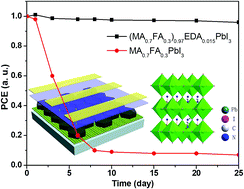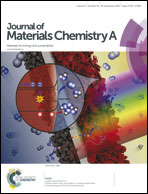Methylammonium, formamidinium and ethylenediamine mixed triple-cation perovskite solar cells with high efficiency and remarkable stability†
Abstract
Solar cells with organic–inorganic perovskites as light absorbers are now delivering more than 22% power conversion efficiencies and are comparable to their inorganic counterparts on a laboratory scale. However, their intrinsic instability hinders the commercialization of this promising photovoltaic technique. Herein we introduced the bivalent alkyldiammonium cation ethylenediamine (EDA2+) into methylammonium (MA)/formamidinium (FA) lead iodide (MA0.7FA0.3PbI3) to improve its stability, forming a triple cation perovskite (MA0.7FA0.3)1−2xEDAxPbI3 as a light absorber layer for planar perovskite solar cells. After delicately tuning the stoichiometric ratio of EDA2+ in the cation, PSCs based on the (MA0.7FA0.3)0.97EDA0.015PbI3 (x = 1.5%) perovskite yielded a highest power conversion efficiency of 20.01% with negligible hysteresis. More importantly, the devices showed greatly enhanced stability compared to the EDA-free ones. The unencapsulated perovskite solar cells with EDA incorporation retained 96% of their initial efficiencies after 25 days of storage in an ambient atmosphere.



 Please wait while we load your content...
Please wait while we load your content...